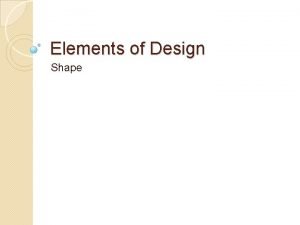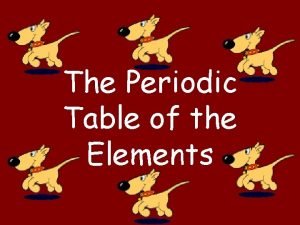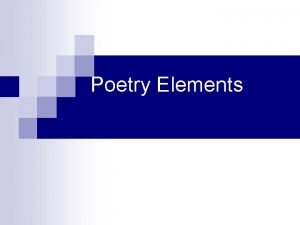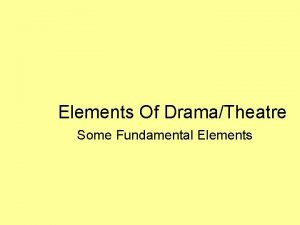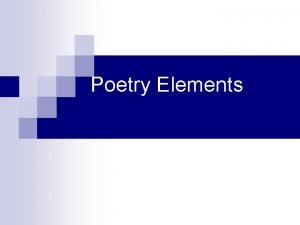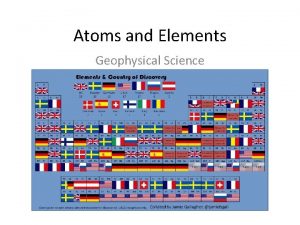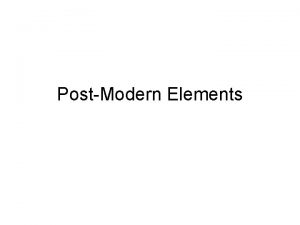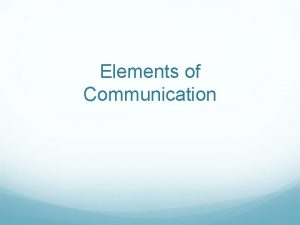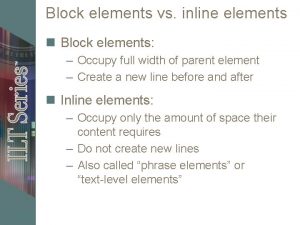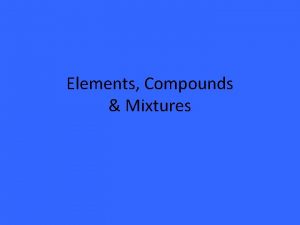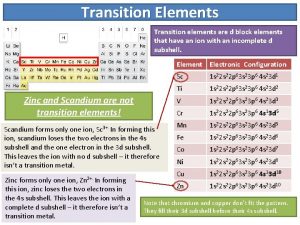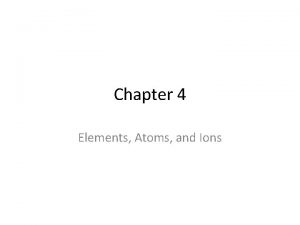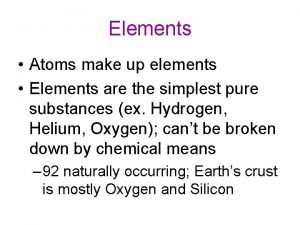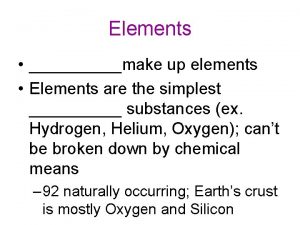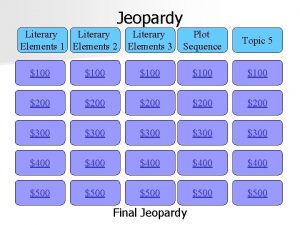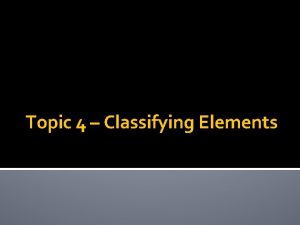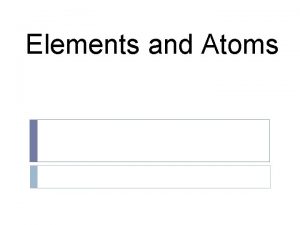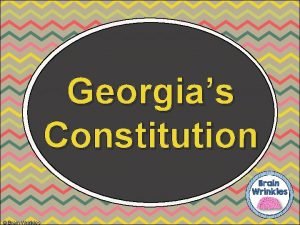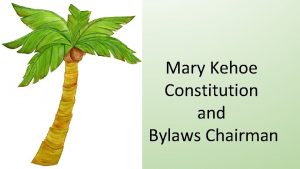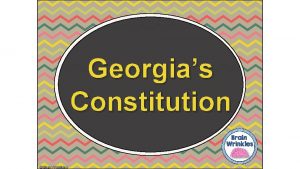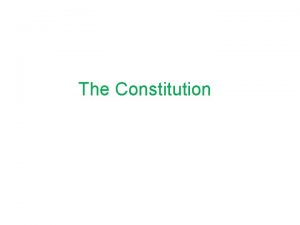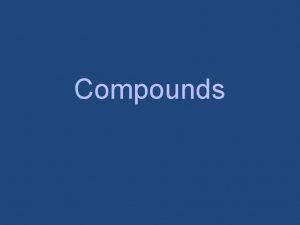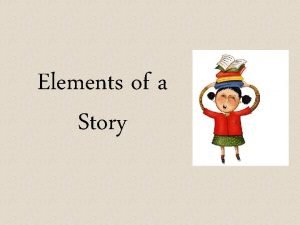US CONSTITUTION ELEMENTS OF THE CONSTITUTION The Constitution






























- Slides: 30

US CONSTITUTION

ELEMENTS OF THE CONSTITUTION • The Constitution provides the basic framework for American government. It also guarantees the rights and freedoms. • The Constitution is a three-part document, consisting of the Preamble, the articles, and the amendments • Constitution serves as both a practical outline for government and a symbol of our national way of life.

THE PREAMBLE SETS THE PURPOSE FIRST PART OF THE CONSTITUTION • The Preamble Sets the Purpose- First part of the Constitution • The opening paragraph, is a single, long sentence that defines the broad purposes of the republican government created by the Constitution. It begins with the phrase “We the people, ” signifying that power and authority in our system of government come from the people, not the states. • The Preamble goes on to set various goals for the nation under the Constitution. These goals are expressed in a series of key phrases.

THE ARTICLES THE SECOND PART OF THE CONSTITUTION • The Articles, the Second Part of the Constitution • They establish our national government. • The main body of the Constitution consists of seven articles. These seven articles are further divided into sections and clauses. • The first three articles establish the three branches of government —legislative, executive, and judicial—and define their powers. These articles lay out the basic structure of the national government. • The four remaining articles of the Constitution cover various subjects, including relations among the states, the supremacy of national law, and the amendment process.

ARTICLES: LEGISLATIVE BRANCH • Article I- Legislative Branch • The first article sets up Congress as the lawmaking body in government. • It describes the two chambers of Congress, the Senate and the House of Representatives, as well as the election, terms, and qualifications of their members. • It also sets guidelines for rules and procedures in each chamber. • This is the longest article in the Constitution, reflecting the founders' belief in the importance of the legislature in a representative democracy.

ARTICLE 1 - LEGISLATIVE BRANCH • With Article 1 lies section 8 - lays out some of the main powers granted to Congress. These powers are both enumerated and implied. Enumerated/Expressed powers are those that are specifically listed in the Constitution, such as the power to collect taxes, coin money, and declare war. • Implied powers are those that the legislature can claim as part of its lawmaking responsibility. This claim to implied power stems from Clause 18 of Section 8, which says that Congress can "make all laws which shall be necessary and proper" for carrying out its duties. This Necessary and Proper Clause is also known as the Elastic Clause, since it can be "stretched" to cover a variety of issues and circumstances. • Why did the Framers include the Necessary and Proper Clause in the Constitution? • To empower Congress to pass laws needed to carry out the express powers

ARTICLE II- EXECUTIVE BRANCH • Article II- Establishes the Executive Branch • The executive branch is led by the president and vice president. As it does for members of Congress, the Constitution describes the election, terms of office, and qualifications of these executive officers. It also defines the powers of the president, which include the power to command the armed forces, to make treaties, and to appoint other executive officials.

ARTICLE III- THE JUDICIAL BRANCH • Article III creates the Supreme Court, the highest court in the land, while leaving Congress to create the lower courts. It defines the jurisdiction of the federal courts, specifying the types of cases that can be tried. It also guarantees the right to trial by jury in criminal cases and defines the crime of treason.

POWERS Legislative Branch • Makes Bills in Laws • Prints Money • Declares war (shared with the President) • Divided into House and Senate • Selected by popular vote. • Approves Presidential Appointments. • Collects Taxes Executive Branch • Enforces Laws • Includes President, Vice President and Cabinet. • Makes treaties with other countries • Selected by Electoral College • Appoints Supreme Court Justices, federal judges, ambassadors and cabinet members. • Makes a State of the Union address each year. Judicial Branch • Decides what a law means • US Supreme Court- highest court • Can declare laws unconstitutional.

COLORING • Key: • 1 color for Executive Branch- Shade the VP a lighter version of this color • 1 Color for the Senate (as part of the Legislative Branch) • 1 Color for the House of Reps (as part of the Legislative Branch) • 1 Color for the Judicial Branch

ARTICLE IV- CONCERNS RELATIONS AMONG THE STATES • Article IV has four sections, which make the following key points: • Full faith and credit. Each state must honor the laws and court decisions of other states. • Treatment of citizens. No state may discriminate against the residents of another state. It must treat them as it treats its own residents. States must return suspected criminals to the states in which they are wanted. • New states and territories. Only Congress can authorize the creation of new states. It also has power over territories and other jurisdictions of the United States. • Protection of states. The national government guarantees each state a republican form of government. It also promises to protect states from outside attack and, if requested, to help states put down internal rebellions.

ARTICLE V- DESCRIBE THE AMENDMENT PROCESS • The framers understood that it might be necessary to make changes to the Constitution from time to time. Article V spells out the ways such amendments can be proposed and ratified.

ARTICLE VI MAKES THE CONSTITUTION THE SUPREME LAW OF THE LAND • Article VI covers several topics. It states that the national government agrees to repay all of the debts that were incurred under the Articles of Confederation. This was critical to ensure support for the new government. • It also states that the Constitution is the "supreme Law of the Land. " This section, known as the Supremacy Clause, means that federal law supersedes all state and local laws. When the laws conflict, federal law reigns supreme. • In addition, it stipulates that all federal and state officials must take an oath swearing their allegiance to the Constitution. Also, no religious standard can be imposed on any official as a qualification for holding office.

ARTICLE VII EXPLAINS THE RATIFICATION PROCESS • Article VII stipulates that the Constitution would not take effect until ratified by at least nine states. Although the Constitution was signed by the framers on September 17, 1787, ratification did not occur until the following year.

AMENDING THE CONSTITUTION • Please note: The Amendment Process is NOT easy. • The president has no formal role in the amendment process. The chief executive can support or oppose a proposed amendment, but has no power to approve or block its passage. That power lies exclusively with Congress and the states.

ESTABLISHING A LIMITED GOVERNMENT • The framers’ main goal in crafting the Constitution was to create a system of limited government. They knew that absolute power often leads to the abuse of rights. On the other hand, they also knew that a lack of governmental power could result in chaos and instability. • The limited government envisioned in the Constitution is based on six guiding principles: (1) popular sovereignty, (2) the rule of law, (3) separation of powers and checks and balances, (4) federalism, (5) an independent judiciary, and (6) individual rights.

GUIDING PRINCIPLE 1 • Popular Sovereignty • This principle lies at the heart of democratic rule. It means that power resides not with the government or its leaders, but with the people. The framers understood that making the people the source of power is the best assurance that government will act in the people’s interest. • The principle of popular sovereignty is expressed in the opening phrase of the Preamble: “We the people. ”

GUIDING PRINCIPLE 2 • The Rule of Law • This principle requires that the American people and their government abide by a system of laws. This is another way to ensure that power is limited and not used in an arbitrary manner

GUIDING PRINCIPLE 3 • Separation of Powers—Checks and Balances • The Constitution divides power in the national government among the three separate branches. This separation of powers was a key component in the framers’ vision of limited government. In The Federalist No. 47, James Madison wrote, “The accumulation of all powers, legislative, executive, and judiciary, in the same hands. . . may justly be pronounced the very definition of tyranny. ” • In the framers’ view, separating the powers of government among the three branches would ensure that no one branch could dominate. The framers took this principle a step further by inserting provisions in the Constitution that would allow each branch to check, or limit, the power of each of the other branches. This system of checks and balances can be seen in many parts of the Constitution • Another clause establishes the president’s veto power over bills passed by Congress. It says that the president can refuse to sign a bill into law and instead send it back to Congress: • Every Bill which shall have passed the House of Representatives and the Senate, shall, before it become a Law, be presented to the President of the United States; If he approve he shall sign it, but if not he shall return it, with his Objections to the House in which it shall have originated. • The only way to remove a president, other members of the executive branch, or federal judges from office is by impeachment. This process requires that a simple majority of House members vote to impeach, or formally charge, the official with wrongdoing. A trial then takes place in the Senate:

GUIDING PRINCIPLE 4 • Federalism • The fourth guiding principle, federalism, divides power between the central government and the various state governments. In creating a federal system of government, the Constitution also established three types of powers: delegated, reserved, and concurrent. • Delegated powers are those powers granted to the national government. Delegated powers may be either enumerated or implied in the Constitution. The delegated powers of the federal government include regulating immigration, making treaties, and declaring war. • Reserved powers are those powers kept by the states. Reserved powers allow states to set marriage and divorce laws, issue driver’s licenses, and establish public schools, among many other things. Under the Constitution, much of the exercise of day-to-day power affecting citizens is carried out by the states. • Concurrent powers are those that are shared by the federal and state governments. Examples of concurrent powers include taxation and law enforcement. Federalism is explored in detail in Chapter 6. • The federalist principle in the Constitution is most evident in articles and amendments that refer to delegated, reserved, and concurrent powers

GUIDING PRINCIPLE 5 • An Independent Judiciary • The fifth guiding principle, an independent judiciary, was considered essential by the framers to support the rule of law and preserve limited government. In The Federalist No. 78, Alexander Hamilton wrote, “The independence of the judges may be an essential safeguard against the effects of occasional ill humors in society. ” In other words, an independent judiciary would protect against abuses of the system by self-interested parties. This principle is found in Article III, which establishes the judicial branch.

GUIDING PRINCIPLE 6 • Individual Rights • The sixth guiding principle, individual rights, played a major role in the struggle to ratify the Constitution. The Anti. Federalists argued that the Constitution did not offer adequate protection for individual rights. The Bill of Rights was added to address their concerns. • Individual rights receive their broadest protection under the First Amendment, which says, • Congress shall make no law respecting an establishment of religion, or prohibiting the free exercise thereof; or abridging the freedom of speech, or of the press, or the right of the people peaceably to assemble, and to petition the Government for a redress of grievances.

INTERPRETING THE CONSTITUTION • Some provisions that did not work as hoped were later changed by the formal amendment process. Other features of the government were established by actions of Congress, the executive branch, and the courts. These changes did not alter the wording of the Constitution, but they did clarify its provisions. • The Supreme Court plays an especially important role in our political system because it has the ultimate power to interpret, or establish the meaning of, the Constitution. Through its decisions, the Court helps to define the limits of constitutional rights and powers. Its decisions can affect your rights as a citizen.

THE PROCESS OF JUDICIAL INTERPRETATION • When judges are asked to apply the Constitution to a legal issue, they look to five sources of information: • 1. The text, or exact wording, of the Constitution itself • 2. The original intent of the framers—what they meant or were trying to achieve—when they debated and wrote the Constitution • 3. Court precedent, or the past decisions of the Supreme Court • 4. The practical consequences for society of a particular interpretation • 5. Basic moral and ethical values • Of these five, the most important are the text of the Constitution, original intent, and precedent.

STRICT CONSTRUCTION- STRICT INTERPRETATION • Strict Construction: Looking at the Text • On one side of this debate are those who favor strict construction, or a literal reading of the Constitution. Legal scholars often call this approach originalism. It holds that the original language of the Constitution and the intent of the framers must serve as primary guides to judicial interpretation. • One of the leading advocates of originalism is Justice Antonin Scalia. In 2005, Scalia observed that “the Constitution is not a living organism. . . it’s a legal document and like all legal documents, it says some things and doesn’t say others. ” Scalia accepts that the Constitution should be interpreted in a reasonable manner. However, he argues that judges should not try to make it conform to modern values. “I do believe you [should] give it the meaning it had when it was adopted, ” he said.

LOOSE CONSTRUCTION- LOOSE INTERPRETATION • Loose Construction: Adapting the Constitution to Today • On the other side of the debate are those who favor loose construction, or a flexible reading of the Constitution. Legal scholars often call this approach interpretivism. It holds that modern values and social consequences must be taken into account in interpreting the Constitution.

THE FIRST TEN AMENDMENTS: THE BILL OF RIGHTS • First Amendment: Basic freedoms. Guarantees five basic freedoms: religion, speech, press, assembly, and petition. • Second Amendment: Right to bear arms. Protects the right to bear arms and form state militias. The national and state governments, however, claim the right to regulate firearms. • Third Amendment: Quartering of soldiers. Bans quartering of troops in private homes during peacetime. This was a key concern in the 1700 s but has little relevance today. • Fourth Amendment: Search and seizure. Prevents unreasonable search and seizure. Police and other authorities have no right to search or seize property or people without just cause. • Fifth Amendment: Rights of the accused. Outlines the right to due process of law and other legal protections. This amendment covers various rights of people accused of crimes. It also covers eminent domain, which prevents the government from taking over private property without just or fair compensation.

THE FIRST TEN AMENDMENTS: THE BILL OF RIGHTS- CONTINUED • Sixth Amendment: Right to a fair trial. Guarantees the right to public and speedy trial by a jury in criminal cases. The accused also has other rights such as to call witnesses and to be represented by an attorney. • Seventh Amendment: Civil trials. Guarantees the right to jury trial in civil cases. A civil case, such as a lawsuit, is one that does not involve criminal conduct. • Eighth Amendment: Bail and punishment. Bans excessive bail and punishment. The courts may not impose unreasonable bail, fines, or cruel and unusual punishment. • Ninth Amendment: Rights retained by the people. Guarantees other rights not listed in the Constitution or Bill of Rights. • Tenth Amendment: States’ rights. Reserves powers for the states and the people that are not specifically given to the national government. Reserved Powers Clause: When the Constitution is silent about an issue, the power belongs to first the state, then to the people.

POWERS OF THE 3 BRANCHES OF GOVERNMENT • Legislative Branch (Congress): • • Makes the laws Appropriates funds for laws and programs Approves treaties and executive appointments Establishes federal courts • Executive Branch (President): • • Enforces the laws Acts as commander in chief of the military Negotiates Treaties Appoints Federal Judges and other top officials • Judicial Branch (Supreme Court): • • Interprets the laws Reviews lower-court decisions Judges whether laws and executive actions are constitutional Rules on cases between states

CHECKS AND BALANCES • The system of checks and balances is a guiding principle of the constitution and a key component of limited government. This system works to prevent any one branch from wielding too much power. • Executive Check on Legislative Branch: • Can approve or veto bills, call special sessions of Congress, and recommend legislation. • Executive Check on Judicial Branch: • Can nominate Supreme Court justices and federal judges. • Legislative Checks on the Executive Branch: • Can override presidential vetoes, approve or reject presidential appointments and treaties, and impeach and try the president. • Legislative Checks on Judicial Branch • Can approve or reject nomination of federal judges, create low courts, and remove judges through impeachment. • Judicial Checks on Executive Branch • Can declare treaties and executive acts unconstitutional. Appointments are for life, and judges are free from executive control. • Judicial Checks on Legislative Branch • Can declare laws unconstitutional.
 Nc constitution vs us constitution
Nc constitution vs us constitution Constitution what is constitution
Constitution what is constitution Lesson 1 principles of the constitution
Lesson 1 principles of the constitution Texas constitution vs us constitution
Texas constitution vs us constitution ưu thế lai là gì
ưu thế lai là gì Môn thể thao bắt đầu bằng từ chạy
Môn thể thao bắt đầu bằng từ chạy Tư thế ngồi viết
Tư thế ngồi viết Bàn tay mà dây bẩn
Bàn tay mà dây bẩn Hình ảnh bộ gõ cơ thể búng tay
Hình ảnh bộ gõ cơ thể búng tay Mật thư anh em như thể tay chân
Mật thư anh em như thể tay chân Từ ngữ thể hiện lòng nhân hậu
Từ ngữ thể hiện lòng nhân hậu Tư thế ngồi viết
Tư thế ngồi viết Ví dụ giọng cùng tên
Ví dụ giọng cùng tên Chó sói
Chó sói Thẻ vin
Thẻ vin Thể thơ truyền thống
Thể thơ truyền thống Khi nào hổ mẹ dạy hổ con săn mồi
Khi nào hổ mẹ dạy hổ con săn mồi Diễn thế sinh thái là
Diễn thế sinh thái là Thế nào là hệ số cao nhất
Thế nào là hệ số cao nhất Vẽ hình chiếu vuông góc của vật thể sau
Vẽ hình chiếu vuông góc của vật thể sau Phép trừ bù
Phép trừ bù Lời thề hippocrates
Lời thề hippocrates Vẽ hình chiếu đứng bằng cạnh của vật thể
Vẽ hình chiếu đứng bằng cạnh của vật thể Tư thế worm breton
Tư thế worm breton đại từ thay thế
đại từ thay thế Quá trình desamine hóa có thể tạo ra
Quá trình desamine hóa có thể tạo ra Sự nuôi và dạy con của hổ
Sự nuôi và dạy con của hổ Thế nào là mạng điện lắp đặt kiểu nổi
Thế nào là mạng điện lắp đặt kiểu nổi Các châu lục và đại dương trên thế giới
Các châu lục và đại dương trên thế giới Dạng đột biến một nhiễm là
Dạng đột biến một nhiễm là






























